- GADHER COMMUNITY
- Guru Guidance & Hinduism
- Gotra, Kuldevis & Nived
- Our historical sites
- Blessings & Festivals
- Gadher Community of today
- Gadher Family Tree
- Essence of Life
- Gadher Pluralism
- Gadher young generation
- Amazing Africa
- Incredible India
- Nostalgia
- Origin of this Website
- Dedication
- Golden Memories
- Achievement
- Jivan Darbar
- Disclaimer & Copyright
Origin and descendants - મૂળ અને .......

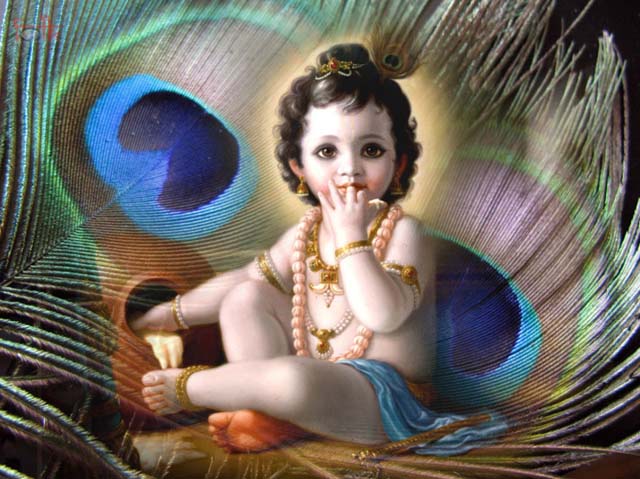
Krishnaism and Gadher Origin
In order to understand our real origin, we need to understand our roots which are well embedded in the lineage of Lord Krishna. The reason for all the epic details below is simply that ‘Gadhers’ are a distant but related lineage to the offspring of Lord Krishna which procreated over the centuries and subsequently to this day. Whilst pages and pages could be written about the ‘Krishna era’, below are some key snippets of information to highlight aspects critical to this website and the Gadher Parivar.
કૃષ્ણષ્ણ અને મૂળ આપણા વાસ્તવિક મૂળને સમજવા માટે, આપણે આપણા મૂળની સમજવાની જરૂર છે જે ભગવાન કૃષ્ણની વંશમાં સારી રીતે જોડાયેલ છે. તમામ મહાકાવ્યોની વિગતો નીચે મુજબ છે કે 'Gadhers' ભગવાન કૃષ્ણના સંતાનને દૂરના પરંતુ સંબંધિત વંશ છે, જે સદીઓથી પ્રગટ થયાં છે અને ત્યારબાદ આજ સુધીમાં. જ્યારે પૃષ્ઠો અને પૃષ્ઠો 'કૃષ્ણ યુગ' વિશે લખાઈ શકે છે, નીચે આ વેબસાઈટ અને ગાધર પરિવાર માટે વિશિષ્ટ પાસાઓને પ્રકાશિત કરવા માટે માહિતીના કેટલાક કી સ્નિપેટ્સ છે.
Lord Krishna
Lord Krishna is the eighth avatar of the God Vishnu or a Supreme God in his own right, a widely revered Hindu deities and the ruler of Shuraseni and Vrishni tribes on the now-submerged island of Dwaraka in Gujarat, India. Worship of the deity Krishna, either in the form of Krishna or in the form of Vasudeva can be traced to as early as the 4th century BC as Svayam Bhagavan, or the supreme-being. Under the Vishnu name, Lord Krishna is listed as the 57th name in the Vishnu form and often shown wearing a golden yellow silk dhoti, a peacock feathered crown and often, pictured with his gopi-consort Radha. He is worshiped as a combined image of ‘Krishna & Radha’.
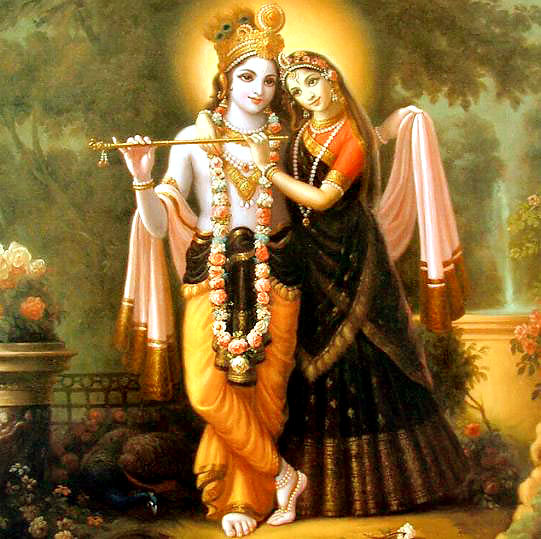
Sri Krishna was an embodiment of divine love and is often the principle focus of the Hindu bhakti or devotional tradition
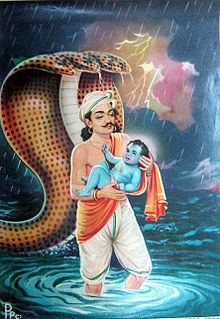
Krishna's great escape at birth when all new born babies were killed!
Krishna is the matchless hero who held the fate of the emperors in the palm of his hand but himself never desired a throne. The great hero who was born in a prison and died in solitude in a forest. He gave the world the Bhagavad Gita. He is the architect of our Dharma which will live forever in the hearts of the people of India and the whole world.”
Based on scriptural details and astrological calculations, the date of Krishna's birth, known as Janmashtami is 21st February, 3228 BC. He was born to Devaki and her husband, Vasudeva and one may remember many stories of his escape from death and atrocities committed by rulers who had reached a stage of no return. When Mother Earth became upset by the sins being committed on Earth, she thought of seeking help from Lord Vishnu. Lord Vishnu agreed to help her and promised her that ‘Krishna - the total incarnation of Lord Vishnu and savior’ would be born on Earth, which he was in the Vrishni clan of Yadavas. Krishna took birth specifically to destroy many of the sinful rulers and especially Kansa.
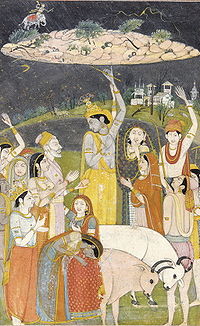
Krishna holding Mount Govardhan to save the people
‘Ras-lila’ and Janmashtami
The playfulness of Krishna has inspired many celebrations like the Ras-lila and Janmashtami where clay pots hung high in the air full of buttermilk are smashed. All this is meant to be a fun celebrations and it gives the worshippers a sense of unity. Many believe that ‘lila’ being connected with Krishna gives Hindus a deeper connection to him and thus a deeper connection to Vishnu, seeing as Krishna is an incarnation of Vishnu. The connectivity between Krishna and the people was immense both at a local human level as well as at a ‘God to be worshipped’ level.
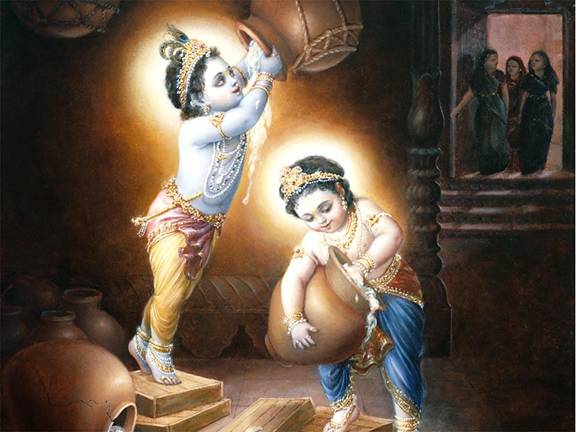
Young Krishna
On his return to Mathura as a young Krishna, he overthrew and killed his maternal uncle, Kansa. He reinstated Kansa's father, Ugrasena as the king of the Yadavas and he became a leading prince at the court. During this period, he became a good friend of Arjun and the Pandava Princes of the Kuru kingdom, who were his cousins. Later, he took his Yadava subjects to the city of Dwarka and established a new kingdom there. Krishna was the prince and commander of the Armies of Dwaraka, whilst Balarama was the crown prince. As expressed in ‘Ras-lila’, there was devotional love and many ‘Gopis’ (herd women) were a big part of this adopting Krishna in many forms. Lord Krishna also had several wives and a large family, which spread across Gujarat – lineages of which form the many different communities across Gujarat and India.
Bhagavad Gita and the Kurukshetra War
Krishna as a king and a friend, tried to mediate between the Pandavas and Kauravas and once battle seemed inevitable, Krishna offered both sides the opportunity to choose between having either his army called Narayani Sena or himself alone, but on the condition that he personally would not raise any weapon. Arjun, on behalf of the Pandavas, chose to have Krishna on their side, and Duryodhan, Kaurava prince, chose Krishna's army. At the time of the great battle, Krishna acted as Arjun's charioteer, since this position did not require the wielding of weapons.
Upon arrival at the battlefield, and seeing that the enemies are his family, his grandfather, his cousins and loved ones, Arjun is moved and says his heart does not allow him to fight and he would rather prefer to renounce the kingdom and puts down his bow. Krishna then advises him about the battle, with the conversation soon extending into a discourse which was later compiled as the Bhagavad Gita - our holy scriptures. The demise of Lord Krishna was self-engineered, including of selected subjects whose time had come to an end, thus bringing the era to an end and ushering in the era of ‘Kali-Yug’.
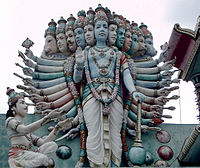
Krishna displays his universal form of Lord Vishnu to Arjun on the battlefield of Kurushetra
Lord Krishna is India’s peerless avatar. His incarnation was when India was facing internal strife. Through his devoted disciple Arjuna, Krishna gave the immortal message of the Bhagavat Gita on the battle fields of Kuruksetra. The Bhagavad Gita is a teaching of the highest divinity.
Kali Yug
According to Puranic source, Krishna's departure marked the end of Dvapara Yug and the start of Kali Yug which is dated to February 3102 BCE. during which Vaishnavas chanted Lord Krishna’s name or “Krishna Naama Sankirtan" which is the constant chanting of Krishna's name as the supreme healer in Kali Yuga. It is meant to destroy sins and purify the hearts through Bhakti or prayers to ensure universal peace.
Vaishnavism
The worship of Krishna is part of Vaishnavism, which regards Vishnu as the supreme God and venerates his associated avatars, their consorts, and related saints and teachers. Krishna is especially looked upon as a full manifestation of Vishnu; however the exact relationship between Krishna and Vishnu is complex and diverse, where Krishna is sometimes considered an independent deity, supreme in his own right. Out of many deities, Krishna is particularly important, and traditions of Vaishnava lines are generally centered either on Vishnu or on Krishna, as supreme. The term Krishnaism has been used to describe the sects of Krishna, reserving the term "Vaishnavism" for sects focusing on Vishnu in which Krishna is an avatar, rather than as a transcendent supreme being. All Vaishnava traditions recognise Krishna as an avatar of Vishnu; others identify Krishna with Vishnu; while traditions, such as Gaudiya, Nimbarka and Vallabha Sampradaya, regard Krishna as the Svayam Bhagavan, original form of God. Lord Swaminarayan the founder of the Swaminarayan Sampeaday also worshipped Krishna as God himself. "Greater Krishnaism" corresponds to the second and dominant phase of Vaishnavism, revolving around the cults of Krishna in the Vedic period and to this day.
Bhakti
Bhakti, meaning devotion, is not confined to any one deity. However Krishna is an important and popular focus of the devotional and ecstatic aspects of Hindu religion, particularly among the Vaishnavas. The bhakti movements devoted to Krishna became prominent in whole of India in the 7th to 9th centuries AD. While the learned sections of the society well versed in Sanskrit could enjoy works like Gita, the masses sang the songs of the devotee-poets, who composed in the regional languages of India. These songs expressing intense personal devotion were written by devotees from all walks of life. The songs of Meerabai and Surdas became epitomes of Krishna-devotion in North India. Due to strong Vaishnava influence in Tamil Nadu, Karnataka, Andhra Pradesh and Kerala, these states have many major Krishna temples and Janmashtami is one of the widely celebrated festivals in South India.
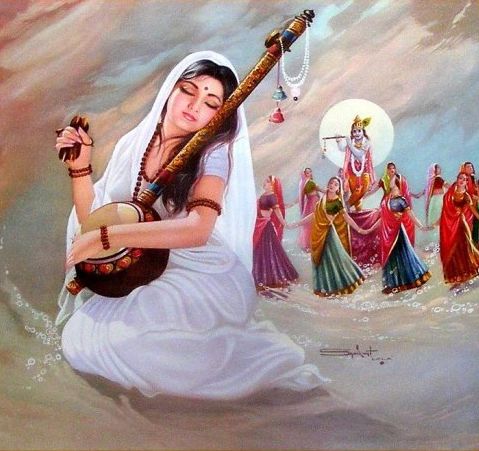
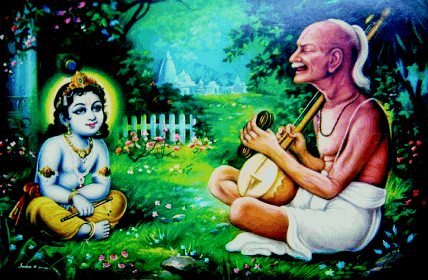
Mirabai Surdas
Mirabai was a great Bhakti saint, Hindu mystic poet and a devotee of the Lord Krishna. Born in the late fifteenth century into a royal family of Rajasthan, Mira, from her childhood was a great devotee of Lord Krishna and wrote many beautiful poems in praise of her Lord. The ‘bhajans’ she wrote so many centuries ago are still sung by Krishna devotees all over the world. However, her life is equally inspiring from another point of view. One may draw parallel between her life and the struggle many modern women have to undergo in order to lead a life of their choice. Married off to Prince Bhoj Raj of Chittor at a tender age she was expected to lead the life of a princess and was pressured into devoting her time to her domestic duties. Yet, young as she was, she stood firm and devoted her life in the service of her Lord. Neither riches nor danger to her life could deter her from her path. When it became impossible to live within the royal household, she chose to leave home and went to Vrindavan, where Lord Krishna had spent his boyhood days. There she led the life of a saint, devoting her time in the service of Lord Krishna.
Our own
Shree Shreebai Mataji Saint Gora Kumbhar
Saint Tukaram
Ancient India
Ancient Kingdoms and all our famous rivers which laid the foundation to various lineages
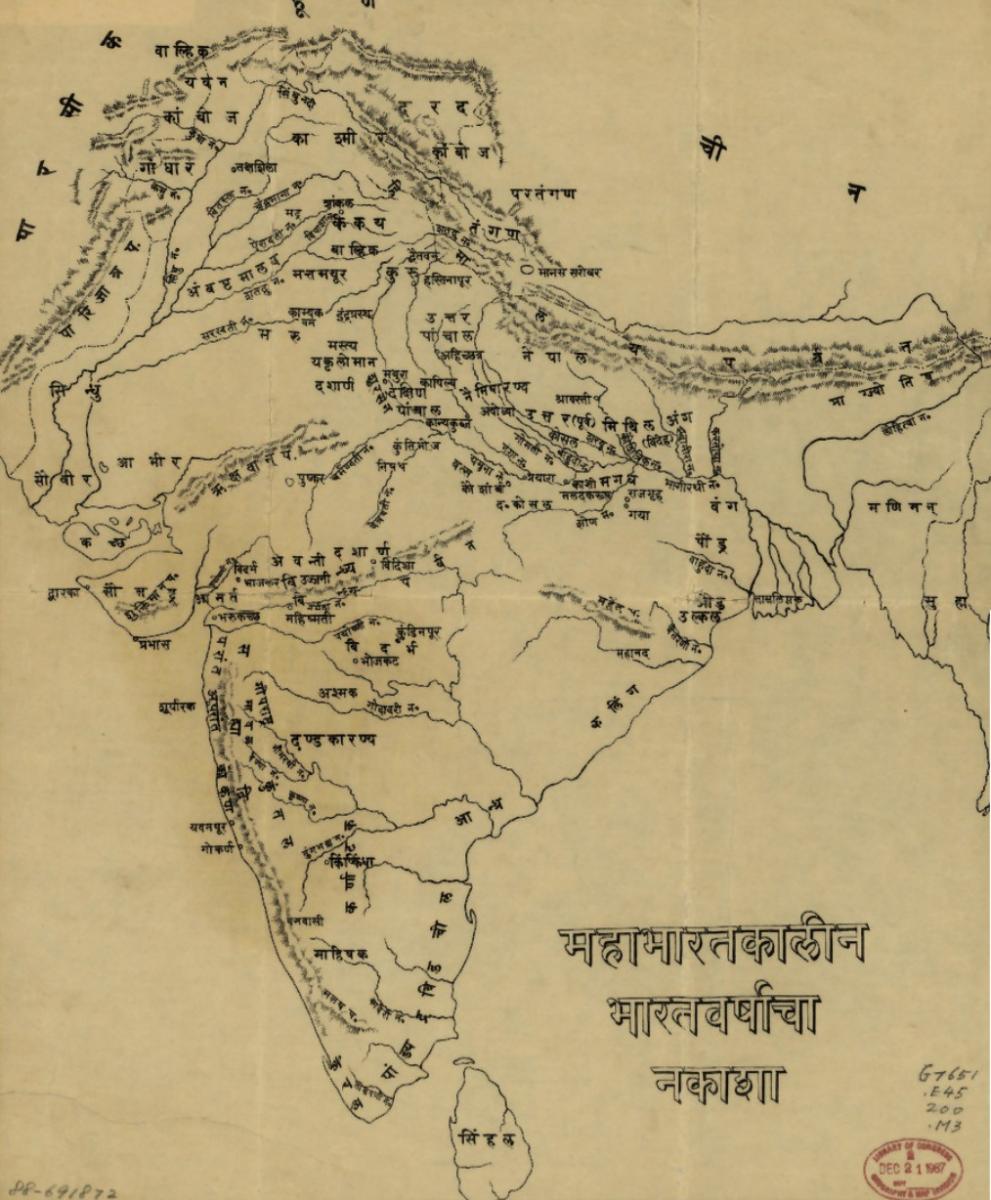
Mahabharata Kingdoms in a simplified format
Various travel routes of Lord Rama
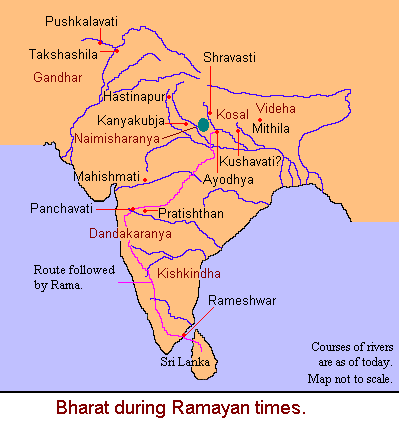
Bharat - After 6th Century with modified names and boundaries - Saurastra started to evolve!

Gadher Parivar roots
Gadher family originated from Chudasama, Rajput Kshatriya family. History reveals that Shree Krishna Bhagwan's 79th Generation of Chandravanshi Chudasama Rajput Kshatriyas gave birth to King Denendra. He had a son named Gajpat, who ruled his kingdom from Junagadh. One of the Chudasama Rajput families led by ...add name... moved in search of a better lifestyle to the region around what is now known as the village of Gadheci. Our ancestors settled here during the difficult period where there were all sorts of calamities, banditry and attacks on both our people and religion. To combat the attacks, our ancestors had to prepare themselves to defend against the invading forces as well as the roaming bandits who had no respect for our women, sisters, property or animals. From this generation and over many years, our family tree has continued to thrive as shown in the ‘Family Tree’ section of this website.
India after partition and new boders
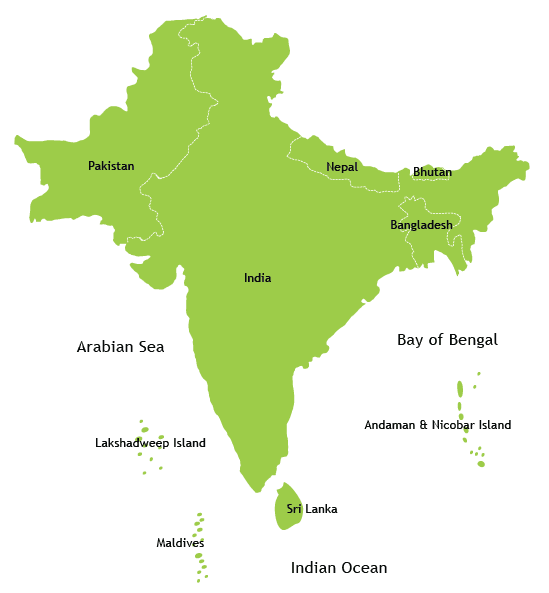
Gujarat of present day and the surrounding regions
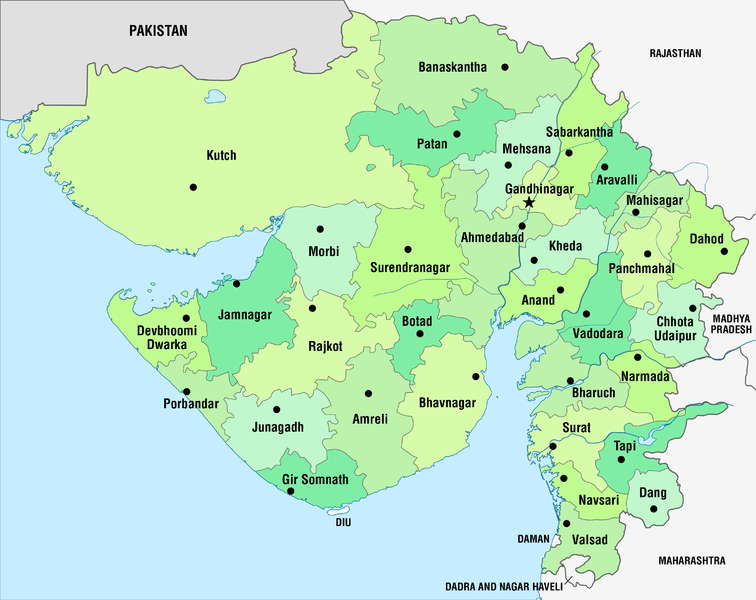
Our origin - Gadhechi
A large number of families settled in the village of Gadhechi and for several years, the life was peaceful and sufficed the needs of the community.

Gadhechi village currently is a panchayat located in the Jamnagar district of Gujarat. Gandhinagar is the state capital for Gadhechi village. The other surrounding state capitals are Daman 447.1 KM., Mumbai 544.7 KM., Raipur 650.7 KM. Gadhechi‘s nearest airport is Jamnagar Airport situated at 100.6 KM distance and the nearest district headquarters is Porbandar situated 97.0 KM distance from Gadhechi. As time went by, the scarcity of water and good farming land as well as meaningful employment, turned their peaceful way of life into a difficult struggle for survival. Many Gadher families started to suffer in the village and a decision was taken to leave Gadheci for good.
Decision was made to migrate to Ranavav in Saurastra.
- Ranavav - as the name referes to, Ran = Rana Shaib and was a well known vav or a water well (vav) and hence the name Ranavav. Rana Shaib was the princly owner of the land around Porbandar and it was his water which attracted the families as there was extream famine in other parts of Gujarat. In order to survive, many of our decendants had to turn their hands to farming and a good combination of arable land and water facilitiated this. Those who had the man power to farm the land, quickly took to farming and others turned to crafts that would support the community. This included carpentry, pottery, house building and tasks which would earn them their keep.
Migration to Ranavav and the surrounding
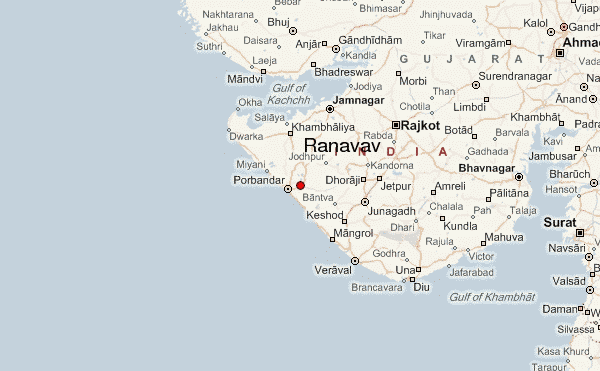
Ranavav and the villages nearby


Besides Ranavav, many Gadher familes scattered around to surrounding areas too. This included Tarsai, Bordi, Vadwara, Navagam, and Porbandar.
Role of Gujarat and Gujaratis in the Independence of India
What a history and what a powerful history too! No one would have thought that the seed of the struggle for Indian Independance would be planted in Gujarat - more importantly Porbandar / Ranavav and its ideology and efforts would defeat the mighty Britsh Empire with non-violance! Gandhiji was born in Parbandar which is now slowly merging with Ranavav and its surroundings.
Independence was hard fought and today we are what we are and where we are due to many of these historical events and reasons. Many of our elders were involved in the freedom struggle to free Bharat Mata from the colonial rule - the 'history of Indepence' by 'non-violent' means remains something incredible which no nation on earth has yet achieved against so powerful a nation!
Summary of Gujarat
Having derived its name from Gujjaratta, meaning the land of the Gujjars, a tribe which migrated to India around the 5th century AD, Gujarat has its history dating back to Indus Valley and Harappan centers that have been discovered here. Gradually with the advent of the Yadava tribe led by Lord Krishna, some 3,500 years ago, Gujarat reached its most glorious days. History about Gujarat says that Ashoka, the Mauryan king extended his kingdom to Gujarat. The downfall of the Maurya Empire subsequently led the smaller kingdoms to establish their authority in this state. The state prospered greatly during the time of Solankis from the 9th century. In the 12th century AD, Allauddin Khilji, the Sultan of Delhi defeated the Waghela king of Gujarat and a long era of Muslims started. Power changed hands to the Marathas and ended the Muslim rule in the 18th century only to be further transferred to the British in the early 19th century. The East India Company set up its first center in Surat. Gujarat was initially a part of Mumbai state till 1960; and Gujarat’s people decided to have their state divided on the basis of language and culture. This led to creation of the two new states of Gujarat and Maharashtra.
Sources: (UNESCO World Heritage Centre) (IUCN Red List)
Dholavira, Gujarat contains the ruins of an ancient city of the Indus Valley civilization.
It was one of the centers of the Harappan Civilization, which thrived around 3,000 years ago.
Rani-ki-Vav, Gujarat
Known as the Queen's Stepwell, Rani-ki-Vav in the town of Patan stands as one of the finest examples of a stepwell found anywhere. It is vast, consisting of seven levels, each of which is sumptuously decorated with stone carvings and sculptures depicting religious and secular themes.
Gadher history and Gujarat history remains our pride and joy!
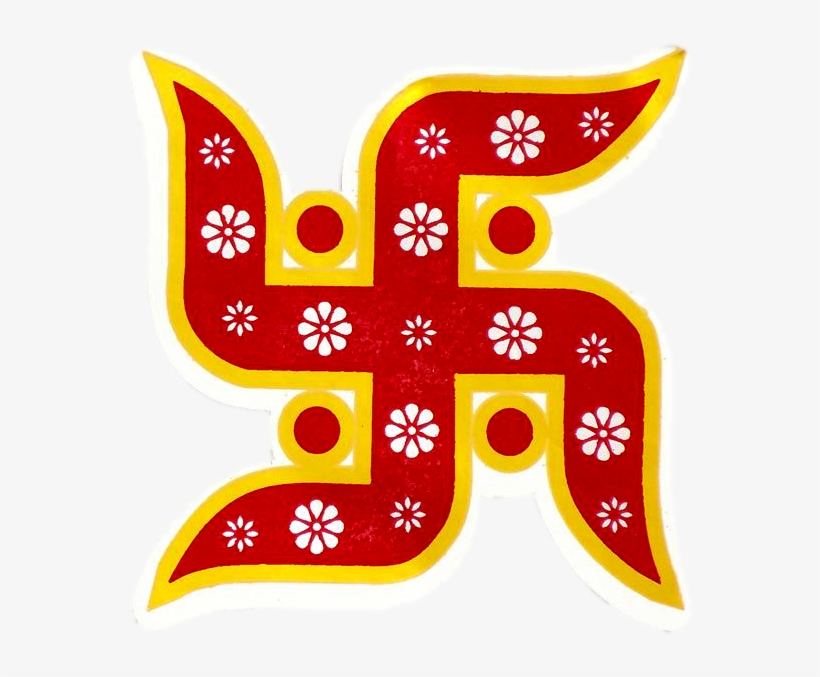
Jivanbhai's saying about Krishnaism:
To be born in such a 'bhoomi' or associated with, where the footprints of Lord Krishna have left an indelible mark and to be part of his lineage is indeed a highest accolade for us - do not squander this previledge but try to build on it !
वसुदेवसुतं देवं कंसचाणूरमर्दनम्
देवकीपरमानन्दं कृष्णं वंदे जगद्गुरुम् || १ ||
vasudevasutaḿ devaḿ kaḿsa-cāṇūra-mardanam
devakī-paramānandaḿ kṛṣṇaḿ vande jagadgurum
